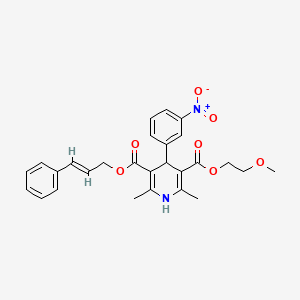Drug
D0849 | cilnidipine
C
C08CA14 Cilnidipine
[C08CA] Dihydropyridine derivatives
[C08C] SELECTIVE CALCIUM CHANNEL BLOCKERS WITH MAINLY VASCULAR EFFECTS
[C08] CALCIUM CHANNEL BLOCKERS
[C] Cardiovascular system
| Toxicity | Dose | Time | Species | Model | Method | Action | Positive criterion | Reference |
|---|---|---|---|---|---|---|---|---|
| MEMBRANE POTENTIAL | 12.53±1.78 | human | qHTS-HepG2 | MMP assay | decrease | IC50 | 163 | |
| MEMBRANE POTENTIAL | 12.27 | human | HepG2 | MMP assay | decrease | IC50 | 163 | |
| MEMBRANE POTENTIAL | 14.79±8.07 | rat | hepatocytes | MMP assay | decrease | IC50 | 163 | |
| Pictogram | Signal | Statements | Precautionary Statement Codes |
|---|---|---|---|
 |
Danger |
Aggregated GHS information provided by 39 companies from 2 notifications to the ECHA C&L Inventory. H318 (97.44%): Causes serious eye damage [Danger Serious eye damage/eye irritation] Information may vary between notifications depending on impurities, additives, and other factors. The percentage value in parenthesis indicates the notified classification ratio from companies that provide hazard codes. Only hazard codes with percentage values above 10% are shown. |
P280, P305+P351+P338, and P310; (The corresponding statement to each P-code can be found at the GHS Classification page.) |
| Organism | Test type | Route | Dose (normalized dose) | Effect | Source |
|---|---|---|---|---|---|
| mouse | LD50 | subcutaneous | > 5gm/kg (5000mg/kg) | Yakuri to Chiryo. Pharmacology and Therapeutics. Vol. 20(Suppl, | |
| rat | LD50 | subcutaneous | > 5gm/kg (5000mg/kg) | Yakuri to Chiryo. Pharmacology and Therapeutics. Vol. 20(Suppl, | |
| mouse | LD50 | intraperitoneal | 1845mg/kg (1845mg/kg) | Yakuri to Chiryo. Pharmacology and Therapeutics. Vol. 20(Suppl, | |
| rat | LD50 | oral | 4412mg/kg (4412mg/kg) | skin and appendages (skin): hair: other | Yakuri to Chiryo. Pharmacology and Therapeutics. Vol. 20(Suppl, |
| dog | LD50 | oral | > 2gm/kg (2000mg/kg) | Yakuri to Chiryo. Pharmacology and Therapeutics. Vol. 20(Suppl, | |
| rat | LD50 | intraperitoneal | 426mg/kg (426mg/kg) | Yakuri to Chiryo. Pharmacology and Therapeutics. Vol. 20(Suppl, | |
| mouse | LD50 | oral | > 5gm/kg (5000mg/kg) | Yakuri to Chiryo. Pharmacology and Therapeutics. Vol. 20(Suppl, | |
| (+-)-(E)-Cinnamyl 2-methoxyethyl 1,4-dihydro-2,6-dimethyl-4-(m-nitrophenyl)-3,5-pyridinedicarboxylate | 1,4-Dihydro-2,6-dimethyl-4-(3-nitrophenyl)-3,5-pyridinedicarboxylic acid 2-methoxyethyl (2E)-3-phenyl-2-propenyl ester | 132203-70-4 |
| 2-Methoxyethyl (2E)-3-Phenyl-2-propenyl 1,4-Dihydro-2,6-dimethyl-4-(3-nitrophenyl)-3,5-pyridinedicarboxylate | 2-methoxyethyl (2E)-3-phenylprop-2-en-1-yl 2,6-dimethyl-4-(3-nitrophenyl)-1,4-dihydropyridine-3,5-dicarboxylate | 2-methoxyethyl-3-phenyl-2-propen-1-yl-1,4-dihydro-2,6-dimethyl-4-(3-nitrophenyl)pyridine-3,5-dicarboxylate |
| 203C704 | 3,5-Pyridinedicarboxylic acid, 1,4-dihydro-2,6-dimethyl-4-(3-nitrophenyl)-, 2-methoxyethyl 3-phenyl-2-propenyl ester, (E)-(+-)- | 3,5-Pyridinedicarboxylic acid, 1,4-dihydro-2,6-dimethyl-4-(3-nitrophenyl)-, 3-(2-methoxyethyl) 5-[(2E)-3-phenyl-2-propen-1-yl] ester |
| 3,5-Pyridinedicarboxylic acid, 1,4-dihydro-2,6-dimethyl-4-(3-nitrophenyl)-,2-methoxyethyl 3-phenyl-2-propenyl ester, (E)-(+-)- | 3-cinnamyl 5-(2-methoxyethyl) 2,6-dimethyl-4-(3-nitrophenyl)-1,4-dihydropyridine-3,5-dicarboxylate | AB0004990 |
| AB01274755-01 | AB01274755-02 | AB01274755_03 |
| AB2000034 | AC-270 | AKOS005558085 |
| Atelec | Atelec (TN) | BCP22689 |
| BDBM50101813 | BRD-A07875874-001-01-6 | C27H28N2O7 |
| CAS-132203-70-4 | CCG-221188 | CCG-221726 |
| CHEBI:31399 | CHEBI:91506 | CHEMBL452076 |
| CS-1133 | Cilnidipine (JP17/INN) | Cilnidipine [INN] |
| Cilnidipine, 99% | Cilnidipine, >=98% (HPLC), powder | Cinaldipine |
| Cinalong | D01173 | DB09232 |
| DSSTox_CID_26309 | DSSTox_GSID_46309 | DSSTox_RID_81530 |
| DTXSID0046309 | EBD38396 | F2173-0669 |
| FRC 8653 | FRC 8653 | FRC 8653, 132203-70-4 |
| FRC-8653 | FRC-8653 | FRC8653 |
| GTPL7767 | H738 | HMS2089J07 |
| HMS3261E06 | HMS3413L13 | HMS3677L13 |
| HMS3715N17 | HY-17404 | J-006141 |
| K-4145 | KS-1294 | LP00422 |
| LS-131293 | MFCD00865853 | NCGC00162150-01 |
| NCGC00162150-02 | NCGC00162150-03 | NCGC00162150-04 |
| NCGC00261107-01 | O3-(2-methoxyethyl) O5-(3-phenylprop-2-enyl) 2,6-dimethyl-4-(3-nitrophenyl)-1,4-dihydropyridine-3,5-dicarboxylate; | Q731525 |
| RT-012023 | SC-25763 | SCHEMBL25550 |
| SR-05000001454 | SR-05000001454-1 | SR-05000001454-2 |
| ST24042102 | STK623341 | SW219784-1 |
| Siscard | Tox21_112001 | Tox21_112001_1 |
| Tox21_500422 | cilnidipine | s1293 |
| DrugBank Name | cilnidipine |
| DrugBank | DB09232 |
| CAS Number | 132203-70-4, 80621-81-4 |
| PubChem Compound | 5282138 |
| KEGG Drug | D01173 |
| ChEBI | 31399 |

